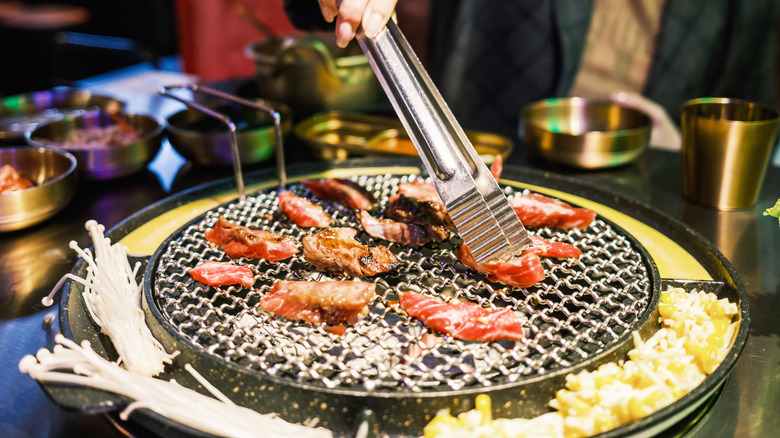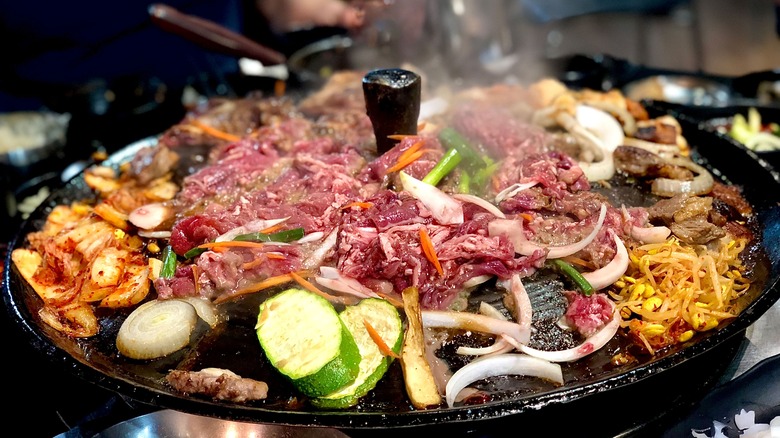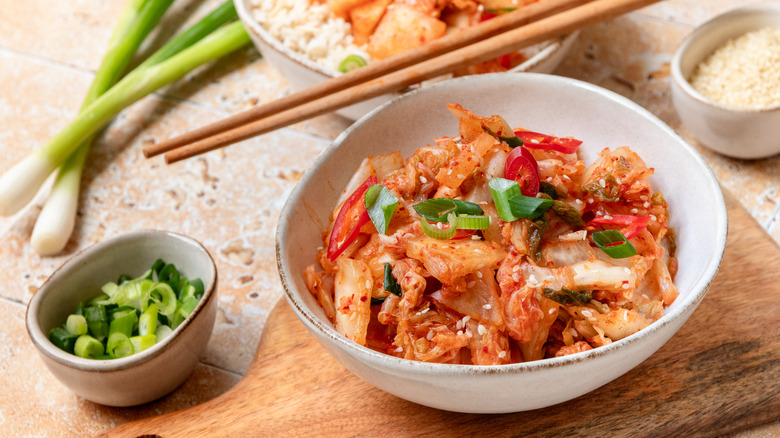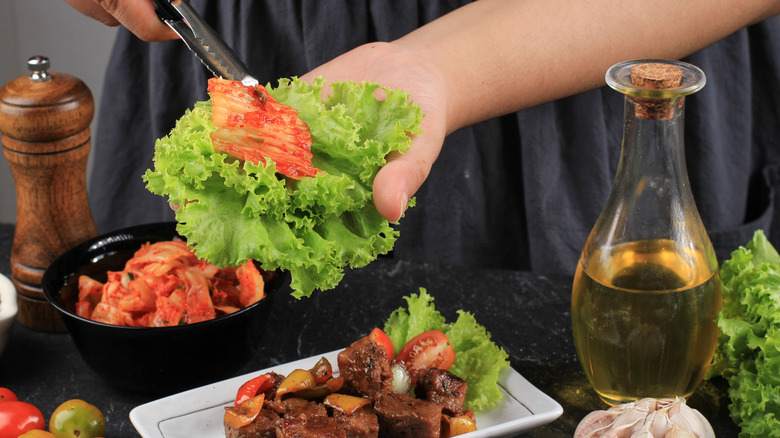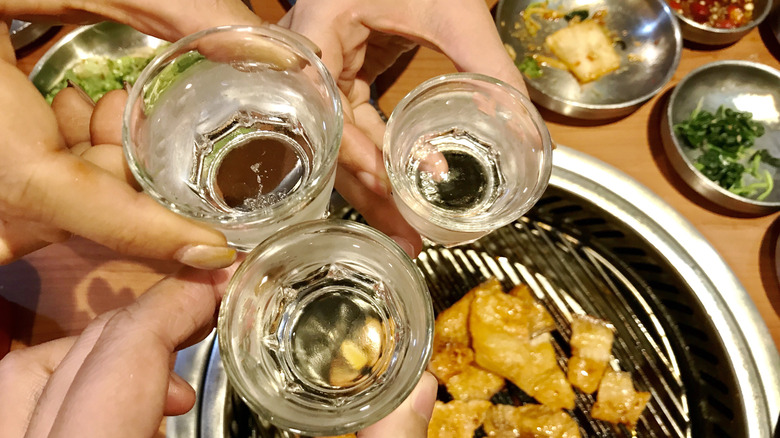5 Tips For Eating Korean Barbecue For An Unforgettable Meal
Korean barbecue is a type of cuisine that's growing increasingly popular worldwide. Typically a group affair, the meal involves cooking meats on a tabletop grill and assembling ssam, in which the grilled foods, garnishes, and sauces are wrapped in another food, most often a leafy green. Korean barbecue can be traced back to the Koguryŏ Era, which lasted from 37 B.C. to 668 BCE, when people would cook their meat over a fire with a skewer or stick.
Are you looking to have the perfect Korean barbecue experience? Then look no further; David Shim, executive chef of COTE Korean Steakhouse (famously one of celebrity chef Gordon Ramsay's favorite NYC restaurants), gave Chowhound the rundown on how to best enjoy the dining experience. However, if you're in the New York City area, and would rather see Shim's experience firsthand, Shim and COTE (alongside many top New York City restaurants, mixologists, and chefs) will be participating in City Harvest's BID 2024: CHTV! tasting event on Tuesday, October 29, in support of feeding New Yorkers in need.
Nobody knows Korean barbecue like Shim, as COTE has been recognized as the first and only Michelin-starred Korean steakhouse in the United States. Shim told Chowhound how to curate the perfect Korean barbecue experience and shared his insight on what items are "must-haves," how to best order the meal, what drinks to pair with your food, and more.
Keep tongs and scissors on hand
To ensure that you and your guests are having a top-tier Korean barbecue experience, it's crucial to have the proper equipment — plus, you have to know how to use it. David Shim told Chowhound that items such as a tried-and-tested grill and proper scissors will facilitate a great experience. "I always love having scissors available," the chef says. "They're a super versatile item and allow the guest to cut many different items tableside without a cutting board and a knife. People can use them at home while cooking as well."
Both scissors and tongs are important for Korean barbecue. The scissors are used to cut the meat slices into smaller portions during the grilling process so they cook faster. Meanwhile, the tongs allow you to grab onto the meat as it's being cut, as well as move the meat slices around the grill to ensure even heating. They can also be used to transfer the meat on and off the grill. So don't be afraid to get hands on with your food and take an active role in preparing it.
Explore the menu with a variety of meats
To enjoy Korean barbecue like a professional, make sure to cook up a few different types of meats. Doing so will diversify the delicious flavor combinations in each bite. "I recommend ordering a couple of different options of beef or pork if available," David Shim told us before noting his personal favorites. "I like to do ribeye or strip, pork belly, and marinated beef short ribs. It covers everything!"
There are several popular meat options that can be used for Korean barbecue, including prime rib, duck, and chicken. These different meats can also be marinated in a variety of flavors, such as soy sauce, chili pepper, or a sweet Korean barbecue sauce. You can also try grilling un-marinated meats so that you and your guests can customize your flavors using the sauces and sides offered with the meal. By ordering multiple meat options, the communal dining experience is not only inclusive for each participant — as someone may not like chicken or a specific cut of meat — but also allows everybody to enjoy the unique tastes and textures that each meat has to offer.
Use side dishes and dipping sauces balance out the meal
When it comes to eating Korean barbecue, David Shim says it's important to have plenty of side dishes and dipping sauces which can help balance out your meal and compliment the barbecued meats. In particular, Shim recommends adding pickled vegetables or kimchi, a variety of lettuces for wraps, and ssamjang, a thick and spicy soybean paste, to your table. He says, "All these work very well because they bring different textures and combinations to anyone enjoying this meal."
If you've only tasted baechu kimchi — the classic variety made from napa cabbage and often referred to simply as kimchi — then you're in for a treat. There are dozens of kimchi varieties like kkadugi (cubed radish kimchi) or baek kimchi (white kimchi) and many other pickled side dishes that can help lighten your meal, add a kick of tangy flavor and provide a satisfying crunch to contrast with the savory barbecued meats.
As for ssamjang, the thick and spicy soybean paste can be used as a spread in your lettuce wraps or dipping sauce for your meat. Shim says, "Even when I'm making Korean BBQ at home, I always have ssamjang on-hand (we make a great one at COTE Korean Steakhouse or I'll pick up some from the store), along with a couple of different lettuce options for ssam."
So, when you're out for your Korean barbecue meal, make sure to have a plethora of options so you can top your meat or assemble a lettuce wrap with the delicious spread of garnishes and side dishes on the table — the more small plates, the better.
Make different bite-sized ssams
Once you have the meats grilling and the side dishes prepared, the next step to enjoying Korean barbecue is to assembling your ssam and luckily, it's much easier than you may think. Ssam is a Korean word that translates to "wrap," and using lettuce as a vessel for your meats and sauces. Popular options for wraps include large lettuce leaves, steamed cabbage leaves, rice cakes, and pickled radishes. The latter two are prepared in thin slices to wrap around the barbecued meat, garnishes, and sides. For basic ssam preparation, you'll want to start with your lettuce variety, then top it with your preferred meat and a variety of sides and garnishes. You can drizzle a sauce on top of your wrap, or you can choose to dip it in a sauce to maximize the flavor in every bite.
When making a ssam, it's important that you don't overfill the vessel, as it's intended to be eaten in one bite (or just a few). Otherwise, almost anything goes. "I don't think there is any right or wrong way to make a ssam," David Shim told us. "It should be a personal combination — one that you or your friends like."
That said, the process requires some trial and error. "It takes a few tries to find the right one — but that's the fun of it," the chef shared. "My go-to is lettuce perilla leaf, ssamjang, scallion salad, and pickled daikon!"
Order party drinks with Korean barbecue
With every great meal comes a great drink pairing. Where Korean barbecue is concerned, David Shim said to focus on the vibe rather than the flavors. "Korean barbecue is about the entire experience and bringing people, cooking, interacting and just having a great time," he said. "If there is already great food, and we have great drink options, it will regardless be an amazing pairing."
The chef went on to share his own go-to drinks, adding, "A personal favorite of mine at Korean barbecue is soju bombs! They add to the entire dining experience. Line up the beer glasses with soju glassing sitting on top, and when everyone is ready, knock them down like domino bricks and let the fun begin. For a more unexpected pairing, I also like to drink rosé because it's a light and refreshing option." A crisp white wine or a straightforward red would also complement a spicy ssam.
You can also enjoy a non-alcoholic beverage with ssam, but consider reaching for something bubbly rather than water. Sodas like Sprite and Coke go well with the atmosphere, as well as the Korean soda Chilsung, which is a carbonated lemon-lime drink. Alternatively, you can order a unique hot tea in a flavor like plum or ginger.
